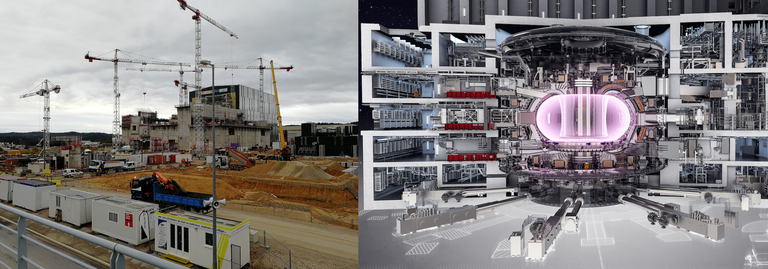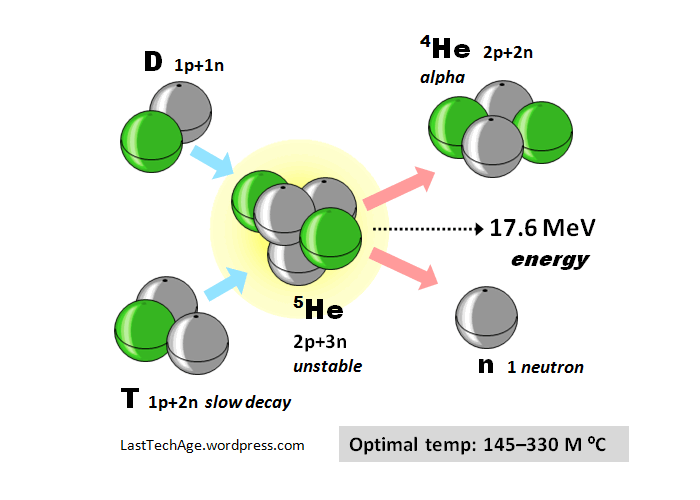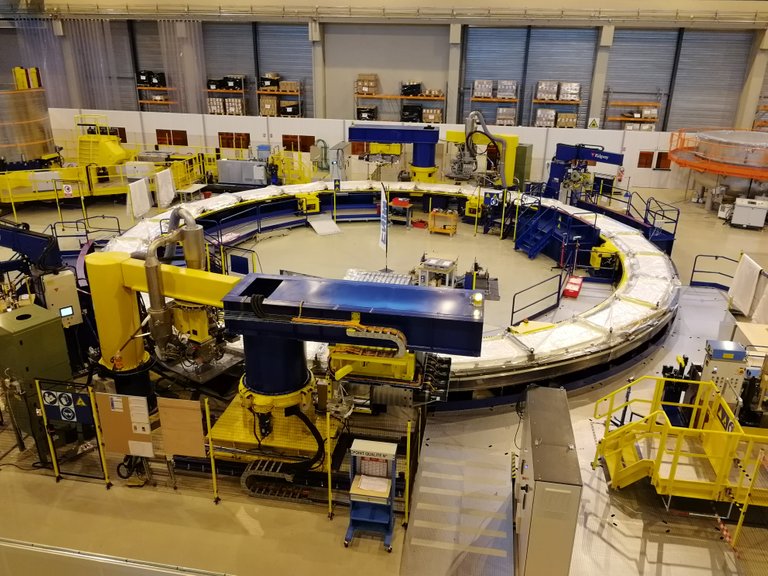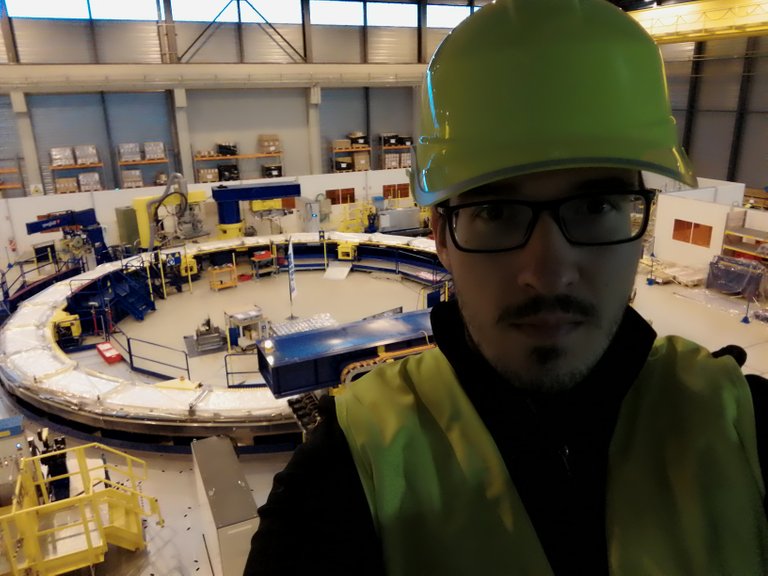
In my previous post I asked myself and more importantly You the question: "What does it take to make Fusion viable?" Well, the answer is a lot. The answer is, that achieving controlled Thermonuclear fusion that can be observed every morning by looking at the Sun, is the greatest and probably most important challenge to face humanity since the invention of fire. "Isnt that a bit extreme?" might you ask, since I appear to be in such a boasting and grandiose mood. No. No it isnt. Let me explain why in a few simple but effective points.
Is a center of a Star really that extreme?
In the center of the Sun and most other stars a Fusion reaction is happening every moment since the brith of our Sun a couple of billion of years ago. Two hydrogen nuclei stripped of their normally surrounding electrons are super-heated because of the massive weight pressing on them to a temperature of about 15 million degrees. Normally these two protons would not like each other at all, because they are positively charged. But in the super-heated and ultra dense environment of a Star center they quickly become close friends during a head-on collision and they merge - Fusion has occured. Because the product of this fusion reaction is lighter than the sum of both protons, the remaining energy was released. This can be seen as light, to put it as plain as possible.
But on Earth two protons will never fuse, because Earth is not heavy enough to produce the gigantic pressures needed. This means this option has to be thrown out of the window. But some hydrogen isotopes exist that can produce fusion energy even on Earth. Because the nuclei of D and T both also contain neutrons, the nuclear force between both nuclei is at a certain temperature larger than the repulsing electrostatic force produced by the proton-proton repulsion. This is great as fusion on Earth becomes a reality. There is only one problem. The temperature needed is 100 million degrees. About 10 times hotter than the center of the Sun.

The D + T reaction with a He nuclei and an additional neutron as products. source
You were not kidding when you said a lot!
In one of my earlies posts I wrote about an Introduction to Fusion energy, purely from a viewpoint of a physicist. But it is wise to take a step back and look at the entire scheme of a tokamak fusion reactor! The very hot plasma that will be inside the reactor cannot hit the walls. The walls of the machine have to be cooled of course as no material in the universe can resist temperatures of 150 million degrees. This means the plasma must be kept inside the device by extremely strong magnetic fields produced using superconducting magnetic field coils cooled down to -269 degrees celsius (4 K). Now think about what I just wrote and try to take it in.

Superconducting magnetic coils that will be cooled to 4 K inside the machine. The diameter of the whole think is 26 meters and it consists of a 2000 km long superconducting NbTi wire. The entire coil must be built to a tolerance of 1 mm.
In the middle of the machine we will have a plasma gas, 10 times hotter than the center of a Sun-like star while only a few meters away the machine walls must be at at liquid Helium temperatures of -269 K. The extreme difference in temperatures is the largest temperature gradient in the known universe. And for the machine to work, it must be kept like this for decades, once commercial devices are built. For such a longterm operation, the device with components as heavy as 1500 metric tons and as large as 40 m must be assembled with a precision of 1 mm.
To what can I compare the heat loads to the machine wall?
Well there is no comparison, really. Because of the huge gradient in temperature some "plasma wind" will hit the wall anyway, as much as we want to avoid it. To minimize the effect on machine performance, the "wind" is redirected onto tungsten plates that are designed to work in extreme conditions of heat fluxes up to 20 MW/m^2. This number is unimaginable to must of us, so lets put it into sum tangible comparisons. An arc welder produces power of about 0.5 MW/m^2. Far worse but still not really comparable, the space shuttle landing produces a heat load of about 1 MW/m^2 on the heat shield.
It is doomed, then?
Well no. If it was, I would not have a job right now. And I am pretty sure I do have one, and ITER is being built.

Proof that ITER is buing built and that I do have a job or I would not be standing in front of the superconducting magnetic field coil.
By some very clever tricks and ingenious solutions to these enourmeous challenges, scientists are making Fusion viable, despite being extremely tough to realize on Earth as a power source. Do not be too happy just yet. The experimental fusion reactor ITER (lat. The way) that is promoted to generate 10x the power as it is put in is scheduled to achieve this goal in 2035. And the first demonstration power plant DEMO is scheduled to be built around 2060, after we see and resolve all the issues that ITER faces. So Fusion as an energy source is not just around the corner. But when we achieve it, we can tap into a almost infinite power source as water, from which D and T are produced, is very abundant on Earth.


steemit.chat.Big thanks to @steemstem for allowing me to use their tag, name and banner in the following series. SteemSTEM is a community driven project which seeks to promote well written/informative Science Technology Engineering and Mathematics postings on Steemit. For more information on the SteemSTEM project join their
StemQ Notice: This post was originally submitted on StemQ.io, a Q&A application for STEM subjects powered by the Steem blockchain.
By coincidence, I was listening to this very subject this morning on YouTube while commuting to work!
ITER is a fascinating experience involving the collaboration of so many countries.
Thank you for sharing your knowledge in this fascinating field!
Well, I intend to write a whole lot more on ITER, as I am curently visiting there, and more broadly on Fusion as I am PhD student on the subject. So if you are interested in the subject defnitly follow me. Not begging, just saying! :)
Yeah
This post has been voted on by the SteemSTEM curation team and voting trail in collaboration with @utopian-io and @curie.
If you appreciate the work we are doing then consider voting all three projects for witness by selecting stem.witness, utopian-io and curie!
For additional information please join us on the SteemSTEM discord and to get to know the rest of the community!
Congratulations @maticpecovnik! You have completed the following achievement on the Steem blockchain and have been rewarded with new badge(s) :
Click here to view your Board of Honor
If you no longer want to receive notifications, reply to this comment with the word
STOPTo support your work, I also upvoted your post!
Do not miss the last post from @steemitboard:
Hi @maticpecovnik!
Your post was upvoted by Utopian.io in cooperation with @steemstem - supporting knowledge, innovation and technological advancement on the Steem Blockchain.
Contribute to Open Source with utopian.io
Learn how to contribute on our website and join the new open source economy.
Want to chat? Join the Utopian Community on Discord https://discord.gg/h52nFrV
Hi @maticpecovnik!
Your UA account score is currently 2.222 which ranks you at #20835 across all Steem accounts.
Your rank has improved 52 places in the last three days (old rank 20887).Your post was upvoted by @steem-ua, new Steem dApp, using UserAuthority for algorithmic post curation!
In our last Algorithmic Curation Round, consisting of 425 contributions, your post is ranked at #316.
Evaluation of your UA score:
Feel free to join our @steem-ua Discord server
Congratulations @maticpecovnik! You have completed the following achievement on the Steem blockchain and have been rewarded with new badge(s) :
Click here to view your Board of Honor
If you no longer want to receive notifications, reply to this comment with the word
STOPDo not miss the last post from @steemitboard:
Another world record for physics :D
Are there already ways to visit ITER? I know it is not fully built yet, but maybe there are interesting things to be seen there.
PS: glad to read again from you!
There are many interesting things to see. The pictures I posted here, except for the first one, and in the next post about fusion are mine and were taken on the ITER site.
I am sure if you gather a group of interested co-workers you can reserve a spot in the ITER guide. We were told about 20k people visit every year.
What about organizing the next steemstem meetup there? Any chance for that?
I really really doubt it. It is still a construction site and security is very strict.
I was imagining that. Not as easy as for CERN or Virgo :)
Nice to meet an ITER colleague here!
Following you from now on
Btw, how is the PF5 coil going?
;-)